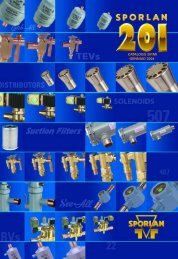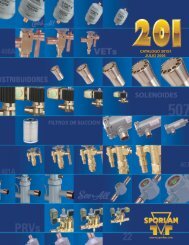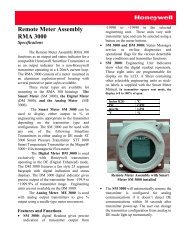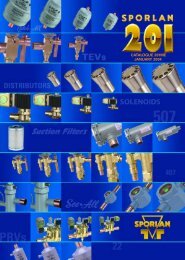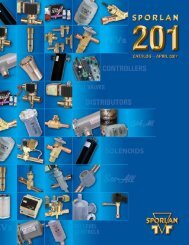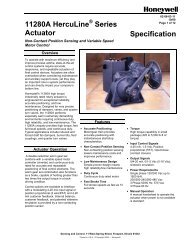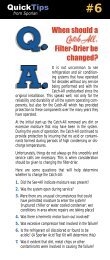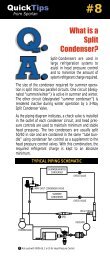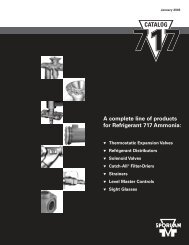Untitled
Untitled
Untitled
You also want an ePaper? Increase the reach of your titles
YUMPU automatically turns print PDFs into web optimized ePapers that Google loves.
Page 38 — CATALOG 410A<br />
Discharge Bypass Valves<br />
410A<br />
Dimensions<br />
HGBE-8 Externally Equalized<br />
HGB-8 Internally Equalized<br />
1.97”<br />
50.0 mm<br />
1.97”<br />
50.0 mm<br />
4.57”<br />
116 mm<br />
3.00”<br />
76.2 mm<br />
4.57”<br />
116 mm<br />
3.00”<br />
76.2 mm<br />
4.66”<br />
118 mm<br />
4.66”<br />
118 mm<br />
0.58” 15 mm<br />
4.66”<br />
118 mm<br />
4.66”<br />
118 mm<br />
0.58” 15 mm<br />
Selection Procedures<br />
The selection of a discharge bypass valve, and the necessary companion<br />
devices, is simplified if complete system information is<br />
available. This will result in the most economical selection because<br />
the components will match the system requirements.<br />
Besides the discharge bypass valve, a specific application may require<br />
a hot gas solenoid valve, an auxiliary side connection distributor or<br />
ASC adapter, and a desuperheating TEV with a companion liquid<br />
line solenoid valve. Once the type of application (review Application<br />
Section on page 36) is determined, the necessary valves can be<br />
selected from the information discussed in this section.<br />
Discharge Bypass Valves<br />
The selection of a Sporlan Discharge Bypass Valve involves five<br />
basic items:<br />
1. Refrigerant – valve capacities vary considerably for different<br />
refrigerants.<br />
2. Minimum allowable evaporating temperature at the<br />
reduced load condition – depending on the system, this value<br />
must be set to prevent coil icing and/or compressor short cycling.<br />
For example, this may be 32°F to 34°F (0°C to 1.1°C) for a water<br />
chiller; 26°F to 28°F (-3.3°C to -2.2°C) for a normal air conditioning<br />
system.<br />
3. Compressor capacity (tons/kW) at minimum allowable<br />
evaporating temperature – consult compressor capacity<br />
ratings for this value.<br />
4. Minimum evaporator load (tons/kW) at which the<br />
system is to be operated – most systems are not required to<br />
operate down to zero load but this value will depend on the type<br />
of system. For example, most air conditioning systems only need<br />
to operate down to 15-25% of full load. However, air conditioning<br />
systems for data processing and “white” rooms, and most refrigeration<br />
systems may be required to bypass to zero load conditions.<br />
5. Condensing temperature when minimum load exists –<br />
since the capacity ratings of the bypass valves are a function of<br />
condensing temperature, it is vital that proper head pressure is<br />
maintained, especially during low load operation. As the capacity<br />
table indicates, a condensing temperature of 80°F (27°C) is considered<br />
the minimum allowable for satisfactory system operation.<br />
See Bulletin 90-30 for information on Sporlan’s Head Pressure<br />
Control Valves.<br />
The discharge bypass valve must be selected to handle the difference<br />
between items 3 and 4 above. If the minimum evaporator load (item<br />
4) is zero, the hot gas bypass requirement is simply the compressor<br />
capacity at the minimum allowable evaporating temperature (item<br />
3). The following discussion on Capacity Ratings, and the example,<br />
show how these factors affect a selection on a typical air conditioning<br />
system.<br />
Capacity Ratings – As the Discharge Bypass Valve Capacity<br />
Table indicates, valve ratings are dependent on the evaporating and<br />
condensing temperature at the reduced load condition and the<br />
refrigerant used. Therefore, once this information and the hot gas<br />
bypass requirement in tons/kW is determined, a discharge bypass<br />
valve can be selected.<br />
As the capacity table heading indicates, these are valve capacities, not<br />
the system capacity on which the valve is applied. The ratings are the<br />
sum of the hot gas bypassed and the liquid refrigerant for desuperheating,<br />
regardless of whether the liquid is fed through the system TEV<br />
or the auxiliary desuperheating TEV. The capacities are based on an<br />
evaporator temperature change of 6°F (3.3°C) from a closed position<br />
to the rated opening. This is a nominal rating value based on years of<br />
application experience. Since a discharge bypass valve is actually a<br />
pressure regulating valve, it should be pointed out that the capacity<br />
ratings based on a 6°F (3.3°C) evaporator temperature change takes<br />
into account that a 6°F (3.3°C) change @ 40°F (4.4°C) on R-410A<br />
is a 14.2 psi (0.98 bar) change. The 6°F (3.3°C) nominal change is<br />
Capacity Multipliers<br />
For Evaporator Temperature Changes Other Than 6°F (3.3°C) Nominal Change<br />
Tons n psi n °F kW n bar n °C<br />
EVAPORATOR<br />
TEMPERATURE<br />
CHANGE °F<br />
EVAPORATOR TEMPERATURE °F<br />
40 26 20<br />
2 0.45 0.40 0.38<br />
4 0.82 0.78 0.76<br />
8 1.08 1.11 1.13<br />
10 1.11 1.17 1.20<br />
EVAPORATOR<br />
TEMPERATURE<br />
CHANGE °C<br />
EVAPORATOR TEMPERATURE °C<br />
5 -3 -10<br />
1 0.41 0.35 0.31<br />
2 0.77 0.72 0.67<br />
3 0.96 0.95 0.94<br />
4 1.05 1.08 1.10<br />
5 1.09 1.14 1.20<br />
6 1.11 1.18 1.25




